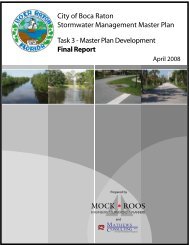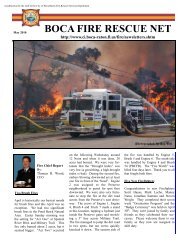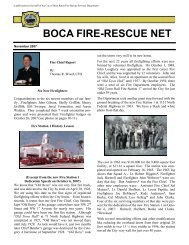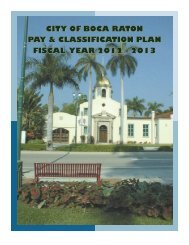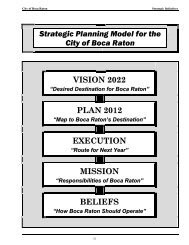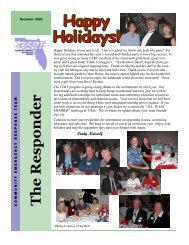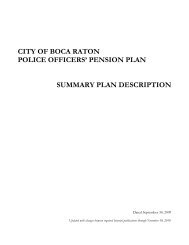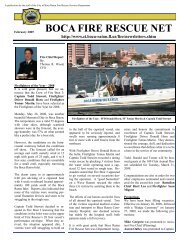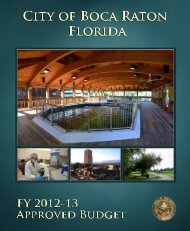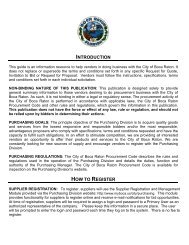General Fire Safety Inspection Checklist - City of Boca Raton
General Fire Safety Inspection Checklist - City of Boca Raton
General Fire Safety Inspection Checklist - City of Boca Raton
You also want an ePaper? Increase the reach of your titles
YUMPU automatically turns print PDFs into web optimized ePapers that Google loves.
____________________________________________________________________________FIRE RESCUE SERVICES DEPT • 6500 CONGRESS AVENUE, SUITE 200 • BOCA RATON, FLORIDA 33487-2808PHONE: (561) 982-4000FAX: (561) 982-4050<strong>General</strong> <strong>Fire</strong> <strong>Safety</strong> <strong>Inspection</strong> <strong>Checklist</strong>FIRE EXTINQUISHERSEXITSA fire extinguisher is required to be within 75 feet <strong>of</strong> every area and within 50 feet from a special hazard, such asthe kitchen or a workshop.<strong>Fire</strong> extinguishers must be checked annually by a licensed service contractor.<strong>Fire</strong> extinguishers should not be hung higher than 5 feet from the floor to the top <strong>of</strong> the extinguisher.Extinguishers are classified as "A", "B", or "C". Type "A" is required for ordinary (wood, paper, some plastics,etc.) hazards.Type "B" is required for liquid (grease, paint, some plastics, etc.) hazards.Type "C" is required for electrical hazards.Multi-purpose ("ABC") extinguishers are available for combined hazards and are the type recommended.There must be at least two exits from every area.Exits must be accessible without the use <strong>of</strong> a key (security can only be provided by approved alarm locks).Exits must be marked with illuminated exit signs that are working.Storage, furniture, trash, etc. are not allowed in corridors or stairways.<strong>Fire</strong> doors to stairways and storage rooms must close and latch automatically.<strong>Fire</strong> doors may not be blocked open (fire doors can only stay open normally if smoke detectors connected toautomatically releasing door holders are installed).The walls and ceilings <strong>of</strong> corridors and stairs must be solid. Any holes or other damage must be repaired.Exits may not be hidden by draperies, furniture, etc.Exit doors must open outwardly.Corridor doors must be solid doors (20 minute fire rated). These must have automatic door closers, unless thereare approved smoke detectors in the corridorsFIRE ALARMS
If a building is equipped with a fire alarm system, it must be fully operable.Each bell or horn, manual alarm station, and smoke or heat detector must work.The alarm stations must be red, and may not be covered or blocked by furniture, posters, drapes, etc.Smoke detectors are required in every room used for sleeping and are recommended in the corridors and stairs.When it is sounding, the fire alarm must be heard in every area <strong>of</strong> the building.WALLS/CEILINGS/FLOORS The interior finish <strong>of</strong> corridors, stairways, foyers, lobbies, and any other exits must be rated Class A or B. Thismeans that paneling, ceiling tile, carpets, decorations, etc. in these areas must be fire retardant.The interior finish <strong>of</strong> all other areas must be rated Class A, B or C. This allows a more flammable finish, but stillprohibits very flammable finishes, such as some wood paneling, paper, some fabrics, etc.The use <strong>of</strong> very flammable decorations is prohibited.MAINTENANCEEvery required safety device (fire alarms, exit lights, fire doors, etc.) must work, and must be kept in good repair.FIRE PROTECTION SYSTEMSSprinkler systems are required in most storage areas, and must be turned on at all times.Extinguisher systems are required to protect the kitchen exhaust hood and deep fryers, griddles, and stove tops.These must be inspected and serviced every six months.STORAGEFlammable liquids (paints, etc.) must be limited to that needed for routine maintenance, and must be stored inapproved storage rooms. Approved storage rooms are rooms separated from the rest <strong>of</strong> the building by 1 hour firerated construction and having a sprinkler system.Gasoline is prohibited from the building, including that in the tanks <strong>of</strong> cycles, mopeds, lawnmowers, and storagecans.Combustible storage (furniture, luggage, paper supplies, lumber, tires, etc.) may only be in approved storagerooms.HOUSEKEEPINGAccumulations <strong>of</strong> combustible debris which could block an exit or could easily be set on fire are prohibited.FIRE DRILLShelter evacuation routes and procedures should be posted in each room/common area.Each dormitory, fraternity, and sorority is advised to conduct a fire exit drill each semester, witnessed by a fireinspector.Emergency contact information, in the event <strong>of</strong> an emergency, should be posted.2
FIRE ESCAPESRailing or gates secured and in place (No open drops).Exits easily opened from the inside without key or special devices.FIRE LANESAreas which are posted by signs or painted curbs are fire lanes. Vehicles parked in these areas would block rescueladder trucks from getting ladders to your window.The above items have been condensed from the fire prevention laws, which apply to residence facilities, includingfraternity and sorority houses. These are not all <strong>of</strong> the fire prevention laws, but include the most common deficienciesfound during campus inspections and are, generally, items which can be corrected before an inspection.Many other fire prevention code requirements pertain to the method and materials used to construct the building. Anydeficiencies <strong>of</strong> this type will be brought to your attention during the fire inspection.3



